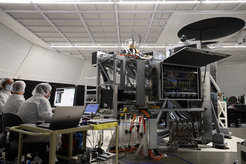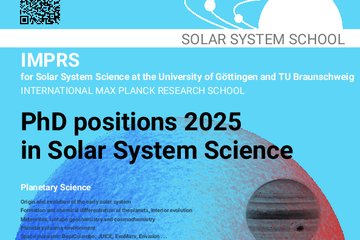The Heart of World’s Largest Solar Telescope Begins to Beat
First Light! The spectro-polarimeter of the world's largest solar telescope in Hawaii looks at the Sun for the first time. The instrument was developed in Germany.
The world's largest solar telescope, the U.S. National Science Foundation (NSF) Daniel K. Inouye Solar Telescope in Hawaii, has reached an important milestone. After almost 15 years of preparation, the German instrument for the Inouye Solar Telescope, the Visible Tunable Filtergraph (VTF), has now taken its first images. The imaging spectro-polarimeter was developed and built at the Institute for Solar Physics (KIS) in Freiburg (Germany). The Max Planck Institute for Solar System Research (MPS) in Göttingen (Germany) is a partner in the project. The data published now were obtained during the technical commissioning of the instrument. VTF analyzes the sunlight captured by the Inouye Solar Telescope in more detail than ever before and, among other things, extracts information on the flow velocity of the solar plasma and the magnetic field strength at the visible surface of the Sun and in the directly adjacent gas layers above. Even in the current technical test phase, VTF is making smallest structures visible. In later scientific operation, when the data is extensively post-processed, the resolution will improve further.

With a primary mirror diameter of four meters, the Inouye Solar Telescope is the largest in the world. Thanks to the optimal observational conditions on the Hawaiian volcano Haleakala and the use of sophisticated methods of image stabilization and reconstruction, the Inouye Solar Telescope has been providing breathtakingly detailed views of our star since 2022: it can make smallest structures visible. To extract as much detailed information as possible about our star from sunlight, the Inouye Solar Telescope is gradually being equipped with additional scientific instruments. They process the incoming light, for example by examining individual wavelength ranges or polarization states of the light separately. Four of the five instruments are already in operation. The latest addition, the world's largest spectro-polarimeter VTF, is the most powerful of them. As part of the technical commissioning, the first images of the Sun have now been taken with VTF. Researchers refer to this milestone as a technical first light.
“The Inouye Solar Telescope was designed to study the underlying physics of the Sun as the driver of space weather. In pursuing this goal, the Inouye is an ideal platform for an unprecedented and pioneering instrument like the VTF”, said Christoph Keller, Director of the National Solar Observatory, which operates the Inouye Solar Telescope.
A Look at the Dynamic Nature of the Sun
The goal of the VTF team is to better understand the dynamic nature of our star. Time and again, the Sun displays powerful eruptions that hurl particles and radiation into space. On Earth, this solar bombardment can trigger spectacular auroras, but can also disrupt technical infrastructure and satellites. With VTF, the Inouye Solar Telescope will peer more precisely than ever before into the region of the Sun where eruptions originate: the visible surface of the Sun, the photosphere, and the adjacent layer of the solar atmosphere, the chromosphere. The complex interaction of hot plasma flows and changing magnetic fields there holds the key to a better understanding of the processes that trigger eruptions. VFT can determine crucial properties such as plasma flow velocity, magnetic field strength, pressure, and temperature.

A Colossus Peering at the Sun
“The commissioning of VTF represents a significant technological advance for the Inouye Solar Telescope. The instrument is, so to speak, the heart of the solar telescope, which is now finally beating at its final destination,” says Matthias Schubert, VTF project scientist at KIS.
VTF is a true colossus. Weighing 5.6 tons and with a footprint roughly the size of a small garage, it occupies two floors. It was developed over the past years at the Institute for Solar Physics in Freiburg (Germany); installation on site at the Inouye Solar Telescope began at the beginning of last year. The total development time was about 15 years, almost as long as that of the solar telescope itself.
The task of VFT is to image the Sun at the highest possible spatial, temporal, and spectral resolution. To filter out individual, very narrow wavelength ranges from the incoming visible sunlight, the instrument uses two Fabry-Pérot interferometers that are unique in the world in terms of their size and precision. This makes it possible to spectrally scan the sunlight with an accuracy of a few picometers. In addition, VTF selects individual polarization states, i.e. the oscillation direction of the light. Two-dimensional images of the Sun are then created for each wavelength and polarization state, from which temperature, pressure, speed, and magnetic field strength at different altitudes of the Sun can be determined. The observational data achieves a spatial resolution of about 10 kilometers per pixel and a temporal resolution of hundreds of images per second.
“VTF enables images of unprecedented quality and thus heralds a new era in ground-based solar observation,” says Sami K. Solanki, director at the MPS.

A First Glimpse
The newly published image utilizes sunlight with a wavelength of 588.9 nanometers. It shows a dark sunspot with its finely structured penumbra in a section of the solar surface measuring approximately 25,000 kilometers by 25,000 kilometers. Sunspots cover the surface of the Sun with varying frequency. They are associated with particularly strong magnetic fields that prevent hot plasma from rising from the interior of the Sun. The image achieves a spatial resolution of 10 kilometers per pixel.
About the Telescope and Instrument
The Daniel K. Inouye Solar Telescope is funded by the US National Science Foundation (NSF) and operated by the National Solar Observatory (NSO). The Visible Tunable Filtergraph (VTF) spectro-polarimeter was developed and built by the Institute for Solar Physics in Freiburg (Germany). Project partners are the Max Planck Institute for Solar System Research (MPS) in Göttingen (Germany) and the Istituto ricerche solari Aldo e Cele Daccò (IRSOL) in Switzerland.














